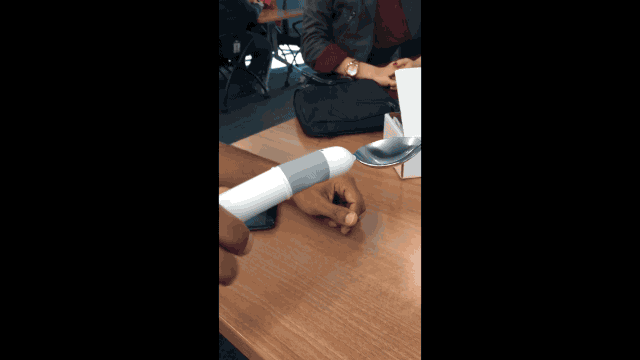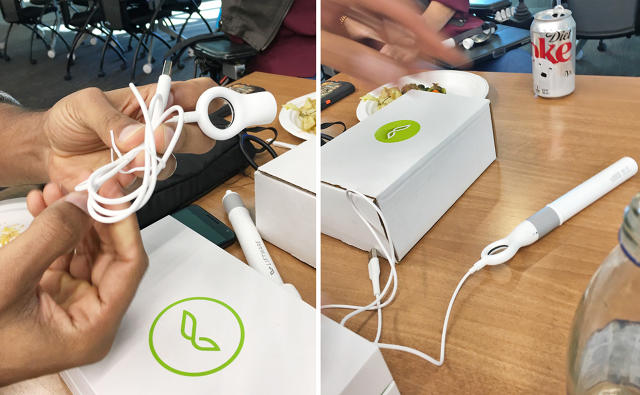Stefanie Putnam, 32, beams with joy as she takes a bite of rice at Verily’s office cafeteria in South San Francisco. She’s here to show off a new spoon that, developed by the research company with her input, can help people with movement disorders eat independently for the first time.
In 2009, Putnam was in a swimming accident that left her paralyzed from her shoulders down to her hands. That didn’t stop her from accomplishing some of her biggest goals, including competing in the World Para-Driving Championships earlier this year. But it did make some everyday tasks challenging.
“Besides breathing, one of the most important things in human life is being able to feed yourself,” says Putnam, who travels with her service dog, Pez. Without the new spoon, she has to be fed by a caregiver or sip food through a straw. “There would be times when my parents would try to feed me, and I’d take it so personally and refuse to eat.”
Putnam has been providing feedback on the spoon, called Liftware Level ($195), for about two years. “Stefanie was involved with the whole process,” says Verily’s technical lead, Anupam Pathak, who manages the Liftware project. “We would have three or four versions for her to try out, and then we’d incorporate a lot of things that she asked for.” The spoon was released to the public on December 1 of this year, with an accompanying fork attachment for $34.95.
As Pathak demonstrates, the spoon integrates sensors on both sides of the handle to allow for a variety of hand movements, including twisting and rotation, while staying level. A strap on the end of the device is designed for users like Stephanie who can’t close their hands easily.

Putnam can use the spoon’s charger thanks to a loop that she can maneuver with her thumb. For other electronics, like computer and phone chargers, she often resorts to using her teeth. “Finally, I’m not risking electrocuting myself,” she says, sighing.

These days, Putnam carries the spoon with her everywhere and eats out with friends without thinking twice. Recently, it occurred to her to ask her father if she could feed him for a change. “I took the spoon and started taking the coffee out of his cup,” she says. “It dawned on me in that moment that I could have a family. I could have children someday and be able to take care of them.”
Sky’s The Limit
Liftware, originally known as Lift Labs, is the brainchild of Pathak, a mechanical engineer who received a grant from the National Institutes of Health in 2010 to create assistive technologies for people with movement disorders. Four years later, Liftware was acquired by Google (now Alphabet), and integrated into the company’s health and life sciences arm, Verily.
The first device to hit the market was Steady, a motion-stabilizing spoon meant to help people with Parkinson’s Disease or essential tremors feed themselves. In 2013, a trial funded by the NIH found that the device canceled out more than 70% of a user’s tremor.
Steady sells for $195, which isn’t cheap, and it isn’t covered by Medicare and private insurers. The company is working with foundations to offer discounts or give out the product for free. And some Veterans Affairs medical centers will pick up the tab. The company says that tens of thousands of these devices are already in use.
For Pathak, the spoon is just the beginning. When he first joined Alphabet, he received an overwhelming response from colleagues who wanted to help. So he threw out a challenge for anyone at the company to prototype attachments for other uses. “We want people to build off what we have,” he says. “With new technologies like 3D printing, we can rapidly test an idea.”
Pathak is particularly proud of one of the attachments, which was inspired by a conversation with Danny, a beta-tester who has cerebral palsy. “The other day, Danny mentioned that he had started painting,” Pathak recalls. “I figured we could help him do that more quickly.” The team hacked together a paintbrush attachment in a matter of weeks. (It is currently not available for consumers.)
In the future, Pathak is hoping to develop an open framework for anyone in the broader technology community to build applications. “The sky is really the limit with this,” he says.
Fast Company , Read Full Story
(50)